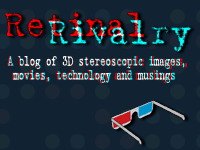First, a little history about the festival. This year’s festival marks the 10th time that the LA 3-D Club has brought the best new independent 3-D motion pictures to audiences in Los Angeles. The LA 3-D Club was established in 1955 to further the art and science of stereoscopic photography. The club’s Movie Division was founded in 1982 by Dr. John E. Hart to focus on 3-D motion picture production. The club held it’s “First Ever Competition” of 3-D short films in March 1997, and subsequent competitions were held at various times over the next decade. The LA 3-D Movie Festival became an annual event in May 2009, when the 7th version of the competiton found it’s home at the Downtown Independent theater. We outfitted the theater with a polarized 3-D projection system and silver screen specifically for the screening of unique and independent 3-D content, and we have been presenting our festival here every year since.
The 10th Annual LA 3-D Movie Festival promises to have a very exciting program including three separate blocks of short films in competiton. Entries include films from the United States, France, Germany, Italy, Scotland, Canada, Korea, and Singapore. One of the blocks will be hosted by Stereo Sisters and will specifically showcase 3-D films with stereography by women.
Festivities begin Friday night with a special screening of the award winning documentary film FLIGHT OF THE BUTTERFLIES at 9pm
We will be joined on Saturday afternoon by a team from NASA/JPL’s Earth Science Center for a special presentation of their new 3-D documentary OUR RESTLESS PLANET, which shows how scientists are using satellite data to study the Earth’s climate, and deal with natural disasters.
The LA 3-D Club’s annual Holiday Party will be held during the film festival on Saturday night, starting with a catered reception at 7pm in the lobby of the theater. Food will be provided by local restaurants, including Indian cuisine from MAYURA. The festivities will continue at 8pm in the theater with the screening of an evening of family friendly 3-D puppet films, including the US premiere of the German marionette film, KALIF STORCH. The Los Angeles Guild of Puppetry will co-host the event.
Sunday afternoon will feature a FREE presentation of the 55th Hollywood International Exhibition of Stereo Photography, featuring all of the image selections and award winning photos presented on the big screen in the theater.
Sunday night we close the festival with a very special double feature starting with COSMIC ENCOUNTERS, a documentary about the International Space Station that follows an astronaut as he trains for a mission into Earth orbit, followed by THE ART OF DIVING, exploring the underwater world of the Red Sea.



